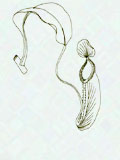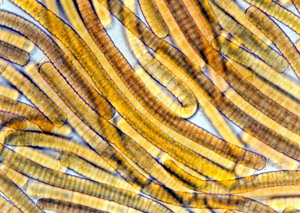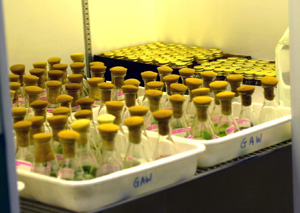

 |
 |
Miscellany
Cyanobacteria culture collection: a unique resource for ecology and biotechnology research
by Sanjay NagarkarCyanobacteria are photo-autotrophic gram negative prokaryotes, also known as blue-green algae. They are the simplest known photo-autotrophic organisms having characteristics of both bacteria and algae and are one of the oldest life forms on earth dating back 3.5 billion years. They grow in a wide variety of habitats and > 2000 species are recorded with many new species still being discovered. Cyanobacteria exhibit three morphological forms, i.e., coccoid, unbranched filamentous and branched filamentous; and two functional groups, i.e., heterocyst bearing, nitrogen fixing, filamentous forms and non-heterocystous, non nitrogen fixing filaments. Although this description is generally true, many non-heterocystous species are known to fix atmospheric nitrogen.
In aquatic habitats, cyanobacteria are regarded as harmful due to their association with environmental problems Ė fouling water bodies, blocking water supplies, unpleasant appearance and stinking odours, causing diseases and toxaemia etc. Due to this image, and a lack of sophisticated techniques to aid their study, scientists have overlooked the more positive attributes of cyanobacteria and branded them as 'nuisance scum'. Initial research focused on their harmful significance, but much of this recently has been re-evaluated to show the positive economic utilization of cyanobacteria. This turnaround is thanks to Spirulina (a non heterocystous filamentous genus of cyanobacteria), which first drew the attention of biotechnologist towards the beneficial aspects of cyanobacteria. Today Spirulina is considered to be 'the richest green food on earth' due to its high nutritional quality. With technological advances and the recent realization of cyanobacteria's immense applied biotechnological potential and suitability for gene manipulation, they have become organisms of choice for research and development. Today we know that cyanobacteria produce a variety of remarkable compound that have shown potential application in major disease management, such as cancer, asthma, arthritis, diabetes, HIV etc (Skulberg, 2000). The application of cyanobacteria is not only restricted to the medical field but they have also showed immense potential in wastewater and industrial effluent treatment, bioremediation of aquatic and terrestrial habitats, chemical industries, biofertilizers, food, feed and fuel, cosmetics, etc (Fatma, 1999). The fundamental prerequisite for exploring the biotechnological potential of cyanobacteria is to screen as many species as possible and this can only be achieved through culture collections.
Quite independently of biotechnologists, and unaware of the biotechnological potential of cyanobacteria, ecologists started to realize the importance of cyanobacteria as important primary producers in freshwater ecosystems. The ecological significance of marine cyanobacteria, however, was overlooked until the early 1990s despite their dominance in marine ecosystems, primarily due to difficulties associated with their identification and quantitative analysis. In marine plankton research, scientists often use large size (>10 m m) plankton nets, which obviously miss most planktonic cyanobacteria which range from 2-6 m m, and this led to the misconception that cyanobacteria are an unimportant component of marine phytoplankton.
The story of intertidal rocky shores is a bit different. Cyanobacteria are visually conspicuous on rocky shores in the form of biofilms and their ecological significance as a primary producer has long been recognized although comprehensive studies were restricted mainly due to technical difficulties. The first comprehensive study on such biofilms was conducted on Hong Kong rocky shores, which described the species richness, spatial and temporal distribution, primary and secondary succession and interactions with physical and biological factors (Nagarkar & Williams, 1997, 1999; Williams et al., 2000).
To better understand the patterns and processes of intertidal community structure, we need to understand the characteristics of individual species and their interaction with various physical and biological factors. This is not possible in the field due to the co-existence of many species in the biofilm. Unialgal or pure cyanobacterial laboratory cultures, therefore, are a prerequisite for conducting such studies and it was towards this goal that I combined my laboratory-based microbiology background and field-based ecological training to embark on an RGC-funded project with Gray Williams (DEB) and Geoff Brown (Chemistry Department) on "The ecological significance and biotechnological potential of Hong Kong marine cyanobacteria". Our main objective was to establish a marine cyanobacteria culture collection.
In collaboration with the National Facility for Marine Cyanobacteria (NFMC), Bharathidasan University, Trichii, India, we have isolated and purified a large number of marine epilithic cyanobacteria from Hong Kong rocky shores. Isolation of cyanobacteria was achieved by streak plate, spread plate and pour plate methods. Based on initial laboratory studies, a modified cyanobacteria growth medium (modified MN medium) was developed along with light intensity and day night cycle protocols for slow growth of cyanobacteria in the laboratory. With such protocols, the first cyanobacteria culture collection was established in NFMC in June 1999. The second was established in the Department of Ecology & Biodiversity (DEB), The University of Hong Kong in July 2000 with the help of Sushanta Saha from NFMC and Wallis Chan and Kelly Lau at DEB. Both culture collections maintain the same strains with similar growth protocols and are collectively known as Bharathidasan & Hong Kong University Culture Collection (BDHKUCC). The NFMC BDHKUCC now contains 168 strains belonging to 72 species of cyanobacteria whereas DEB BDHKUCC contains 110 strains of 48 species. The remaining 58 strains of 24 species will be deposited in the DEB culture collection soon. The strains in BDHKUCC reflect a wide spectrum of morphological and functional forms and belong to all the five major Orders of cyanobacteria; the unicellular strains mainly belong to the genera Chroococcus, Gloeocapsa, Aphanocapsa, Synechocystis and Synechococcus, filamentous strains to Spirulina, Lyngbya, Phormidium, Oscillatoria and Plectonema, and heterocystous strains to Calothrix, Scytonema, Tolypothrix, Nostoc and Dichothrix. The maximum number of strains belong to the genera Aphanocapsa, Chroococcus, Gloeocapsa, Phormidium and Oscillatoria. Strains of the same species are morphologically identical but vary in their colour and habitats (e.g. eutrophic, oceanic or eutrophic waters).
We have prepared a database for this culture collection and an electronic database for general use will be available soon. For convenience, we have assigned a traditional genus and species names under the botanical code system to each strain followed by a culture collection number. As we progress, on the basis of biochemical and genetic characterization, we may change the name of the species but the BDHKUCC number will remain the same. Since a change of name will give more than one name to the strain, we will use P.K.A. (previously known as = old species name) for the new named strain. The cultures are listed alphabetically and multiple strains of the same species are listed in ascending numerical order. The information attributed to each BDHKUCC strain is organized as follows: BDHKUCC accession number, species name & authority, name of growth medium, cell mass colour, collection site (name place and country), date of collection, habitat from where the sample was collected, growth type, i.e., planktonic or epilithic/benthic based on their growth mode in laboratory culture, culture type which describes the stock culture maintenance method, i.e., agar slant or liquid cultures and notes that describe important features related to morphology as developed in the culture.
All the cultures are maintained in photo-autotrophic growth conditions in modified MN medium and are assumed to be axenic. Nitrogen sources have been omitted from the medium to support the growth of nitrogen fixing cyanobacteria. For maintenance, we keep incubation temperature constant at 25° C and light intensity between 20-15-26.87 m E m-2 sec-1 with 12/12 hours Light Day cycle. Culture maintenance protocols are set to minimize growth rates, so as to minimize space, materials and work-load.
BDHKUCC is the largest marine epilithic cyanobacteria culture collection in the world and provides an opportunity for marine ecologists and biotechnologists to perform relatively new studies in their respective fields. Postgraduate and undergraduate students of The University of Hong Kong and Bharadhidasan University are currently using cyanobacteria strains from BDHKUCC for their research projects. A variety of projects are underway using BDHKUCC such as characterization of cyanobacteria for optimum growth, nitrogen fixation, presence of UV-absorbing pigments, photo-pigment compositions, heat and desiccation stress, influence of rock type on growth, nutritional quality of cyanobacteria and its influence on grazers, screening of secondary metabolites and novel compounds, anti-microbial activities, bioremediation of aquatic habitats and industrial effluent and wastewater treatment.
This is a highly valuable collection of global significance that possesses strains not available in any other collections. Many hands are involved in the success of this collection: Mr. Sushanta Saha, Dr. N. Thajuddin and Prof. G. Subramanian from NFMC and Dr. Gray A. Williams, Ms. Wallis Chan, Kelly Lau and Cecily Law from DEB, HKU. The facility is administered by Dr. Williams and maintained by Ms. Law. Please donít hesitate to call Dr. Williams if you want to work in this exciting field and would like to use the facility.
 |
 |
|
Pure
strain of Oscillatoria
|
Cyanobacteria
culture collection
|
Bibliography
Fatma, T. (1999). Cyanobacterial and algal metabolism and environmental biotechnology. Nora Publishing House, New Delhi. pp. 272.
Nagarkar, S. & Williams, G.A. (1997). Comparative techniques to quantify cyanobacteria dominated epilithic biofilms on tropical rocky shores. Mar. Ecol. Prog. Ser. 154: 281-291.
Nagarkar, S. & Williams, G.A. (1999). Spatial and temporal variation of cyanobacteria-dominated epilithic communities on a tropical shore in Hong Kong. Phycologia 38: 385-393.
Skulberg, O.M. (2000). Microalgae as a source of bioactive molecules- experience from cyanophyte research. J. Appl. Phycol. 12: 341-348.
Williams, G.A., Davies M. & Nagarkar, S. (2000). Primary succession on a seasonal tropical rocky shore: the relative roles of spatial heterogeneity and herbivory. Mar. Ecol. Prog. Ser. 203: 81-94.
|
|
P.22-23 |
|
Porcupine! |
 Copyright © 2000 |